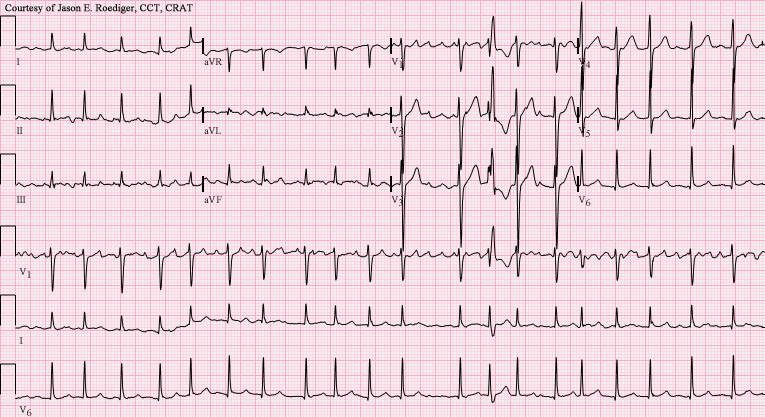- Typical (type I) atrial flutter: saw-tooth-like waves
- Counterclockwise: negative flutter waves in II, III, aVF and positive in V1
- Clockwise: positive flutter waves in II, III, aVF and negative in V1
- Atypical (type II) atrial flutter: doesn’t fulfill the criteria for typical atrial flutter
- No P waves
- Atrial rate typically ca. 400 to 600 bpm
- Heart rate ” Irregularly irregular” and variable (slow Afib < 60 bpm, fast A-fib > 100 bpm)
- Afib has less organized activity in the atria and thus provides less uniform “f” waves.
- Afib has an higher atrial rate (400-600 bpm vs 200-400 bpm for A-flutter)
The difference between atrial fibrillation (Afib) and atrial flutter (Aflutter), is clinically relevant because typical flutter can easily be treated by radiofrequency ablation. Afib and atypical Aflutter requires more expertise and radiofrequency ablation has lower success rate.
Atrial flutter:
Atrial rate ca. 300 bpm (200-400 bpm) with a heart rate typically ca. 150 bpm.
Atrial fibrillation:
Fig.2 Atrial fibrillation ECG (with Ashmann phenomenon)

Distinguish atypical Aflutter from coarse Afib:
It may be difficult to distinguish atypical Aflutter from coarse Afib. ‘Coarse Afib’ has an “f” wave amplitude> 0.5 mm, which can mimic Aflutter “f” waves morphology. Atypical Aflutter may have varying AV conduction, which can cause an irregular heart rhythm.
BUT:

